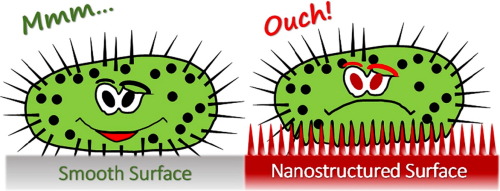Advances in Colloid and Interface Science ( IF 15.9 ) Pub Date : 2017-07-27 , DOI: 10.1016/j.cis.2017.07.030 Abinash Tripathy 1 , Prosenjit Sen 2 , Bo Su 3 , Wuge H Briscoe 4

|
Bacterial antibiotic resistance is becoming more widespread due to excessive use of antibiotics in healthcare and agriculture. At the same time the development of new antibiotics has effectively ground to a hold. Chemical modifications of material surfaces have poor long-term performance in preventing bacterial build-up and hence approaches for realising bactericidal action through physical surface topography have become increasingly important in recent years. The complex nature of the bacteria cell wall interactions with nanostructured surfaces represents many challenges while the design of nanostructured bactericidal surfaces is considered. Here we present a brief overview of the bactericidal behaviour of naturally occurring and bio-inspired nanostructured surfaces against different bacteria through the physico-mechanical rupture of the cell wall. Many parameters affect this process including the size, shape, density, rigidity/flexibility and surface chemistry of the surface nanotextures as well as factors such as bacteria specificity (e.g. gram positive and gram negative) and motility. Different fabrication methods for such bactericidal nanostructured surfaces are summarised.
中文翻译:

天然和仿生纳米结构杀菌表面
由于医疗保健和农业中抗生素的过度使用,细菌抗生素耐药性变得越来越普遍。与此同时,新抗生素的开发实际上已被搁置。材料表面的化学修饰在防止细菌积聚方面的长期性能较差,因此近年来通过物理表面形貌实现杀菌作用的方法变得越来越重要。在考虑纳米结构杀菌表面的设计时,细菌细胞壁与纳米结构表面相互作用的复杂性质带来了许多挑战。在这里,我们简要概述了天然存在和仿生纳米结构表面通过细胞壁的物理机械破裂对不同细菌的杀菌行为。许多参数影响该过程,包括表面纳米纹理的尺寸、形状、密度、刚性/柔性和表面化学以及细菌特异性(例如革兰氏阳性和革兰氏阴性)和运动性等因素。总结了这种杀菌纳米结构表面的不同制造方法。










































 京公网安备 11010802027423号
京公网安备 11010802027423号